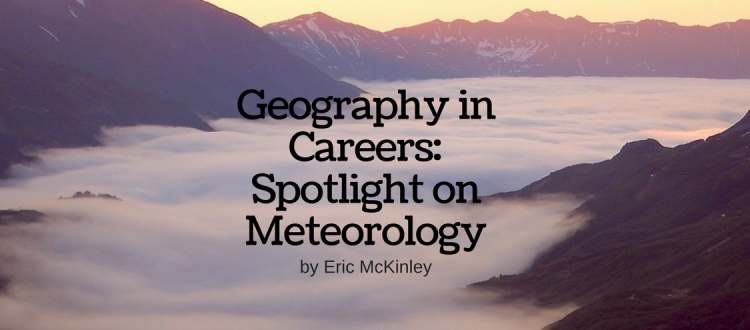Geography in Careers: Spotlight on Meteorology
As a meteorologist, one quickly learns to appreciate the meaning of boundaries. Not so much those of political or property type, but the physical type. The atmosphere is always in motion, always at the whim of changes in temperature and the impacts imposed by physical boundaries – namely Space and the Earth’s surface. I’d like to focus on the latter of those boundaries and the importance of its thorough understanding.
I would argue that if the Earth’s surface was uniform with a highly defined and equitable distribution of water, no mountains, valleys, or changes in vegetation, the science (and art) of forecasting the weather would become somewhat simplistic. Traveling to different destinations for an adventure would be quite disappointing as well! Fortunately, our planet provides an amazing variety of landscapes, oceans, lakes and waterways, all of which influence quite intimately the weather in their particular locale. These locales can be vast, such as the significance of the Gulf Stream to Northern Europe’s ice-free coasts. Or they can be microscale in size, such as valleys acting as sinkholes for cooler air, providing enhanced opportunities for fog. Coastal mountains become rainforests on one side as they force moisture-laden air upward into persistent rains, thus leaving an arid region on the other side. Folks who live along Lakes Erie and Ontario are well aware that when arctic air flows across these warmer lakes, they are accustomed to finding themselves in deep snow.
The examples are endless, and I hope to help the reader understand the criticality of understanding geography. My particular journey as a meteorologist began during the pre-internet (and IT) era with the U.S. Air Force. Radar and Satellite imagery were just starting to become effective resources, but not prevalent. When deployed to a desert environment, I was presented with teletype readouts that provided precious little weather data, blank paper charts and rudimentary instruments. Using my education and training, I would transform this data into a hand-analyzed forecast that I routinely felt less than confident with due to the lack of information, especially when it came to forecasting sand storms. Fortunately, there were maps, and there were local people I could talk to about those maps. With sandstorms being a major challenge, I needed to understand the terrain. Not just the topography, but the make-up of the soil, and where it was. Sand comes in a vast array of particulate size and types. The smaller the particulate, and the lighter the type of soil/sand, the easier it was for wind to lift them off the ground and create havoc for flying operations. Thus, the key was to know the strength and direction of the wind combined with where the lighter weight sand was located. I became very educated in where these regions were, and it successfully influenced my forecast. Knowing the wind direction and speed, especially in desert environments, can be challenging. However, once again, understanding geography greatly helped. In studying the larger scale geography of the land and surrounding seas, I knew a semi-permanent low pressure system would establish itself in a particularly hot region of the desert. This became a driver of not just the wind, but how weather features developed and moved through the region. Geography also helps define where our jet streams typically exist, another driver in weather over a desert.
So why the history lesson in today’s time of highly complex computer analyses and models that produce weather forecasts? Answer: a computer model is meaningless if it does not incorporate a detailed description of the Earth’s surface. In the example of forecasting sandstorms, programmers must incorporate those regions of lightweight sand or dust, among other things. All weather models must include bodies of water, temperatures of that water, mountains, valleys, and more at a scale meaningful to the type of forecast to be provided. Without a complete understanding of the geography that can influence the weather, a meteorologist’s job will always be in jeopardy.
Hopefully, one can also begin to understand that it is not just geography that will drive our weather. An understanding of physics, thermodynamics, fluid dynamics (as we like to treat our atmosphere as a fluid when we study and predict it), chemistry and of course, mathematics are all essential skills. It is through mathematics that we can actually “model” the atmosphere and describe how it reacts to changes in energy, or temperature, and the motion of the Earth itself. Study in these areas is crucial and there are still many things that remain unanswered for the next generation of PhDs to pursue.
I was lucky, my curiosity about why and how certain clouds form or change, and how “air” can enable an aircraft to fly took me to the U.S. Air Force and a lengthy career. Though my undergraduate education was from a small New England college, our lead professor was a retired Air Force weather officer and he guided me down this path. He encouraged me to minor in Geography and Cartography as well. I was fortunate in that my early career in the Air Force was to fly into Hurricanes with the Hurricane Hunters, and my subsequent assignment was gaining a Master’s Degree, courtesy of the Air Force, that focused in Tropical Meteorology. This enabled me to lead investigative flights into Typhoons in the Southeast Pacific Ocean area. Quite the experience for someone who just wanted to know why clouds form and airplanes fly!
The bottom line, weather influences every aspect of our lives. It not only influences what to wear tomorrow, it greatly affects how goods are transported from one nation to another, or how the Sun’s activity impacts our satellites, communications and power supply, and even how our military can successfully operate on the ground, sea and air. It is a career that can expose one to all these aspects and more, limited only by one’s interest in which direction to pursue.
 Eric McKinley is currently a Senior Manager with Accenture Federal Services. He is also a retired Air Force Colonel spending the majority of his career performing a wide variety of duties in the meteorology, climatology, oceanography and intelligence career fields.
Eric McKinley is currently a Senior Manager with Accenture Federal Services. He is also a retired Air Force Colonel spending the majority of his career performing a wide variety of duties in the meteorology, climatology, oceanography and intelligence career fields.









